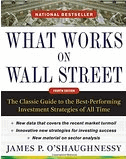“Best Books on Investing”
What Works on Wall Street
James P. O’Shaughnessy

What Works on Wall Street makes our best books on investing list because it uses statistical analysis of historical data rather than anecdotal evidence to create stock investing strategies.
O’Shaughnessy makes a strong case for outperforming the appropriate market benchmark using quantitative investing. Even better, he supplies the strategies that do outperform along with the statistical evidence.
This book is not for the faint of heart – there are almost 400 pages of content with lots of statistical tables and performance charts. However, the return on your time investment will be high.
Be disciplined or stick with index investing
We have met the enemy and he is us.
Pogo
The underlying theme of the book is that all strategies have performance cycles during which they will over- or under-perform their benchmark. It is the disciplined use of proven strategies, not intelligence, which leads to superior performance. Discipline reduces the error introduced by inconsistent behavior. Lacking discipline, you should consider index investing. You may want to check O'Shaughnessy Asset Management for additional info.
Components of Quantitative Investing
There are several core components identified that shape the approach used in What Works on Wall Street:
- Baskets of stocks
- Value investing factors
- Growth and momentum investing factors
- Multi-factor models
Baskets of stocks
O’Shaughnessy begins laying the groundwork for his historical analysis of various investment parameters with some lessons from behavioral finance. In addition, he discusses the concept of a base rate - what can reasonably be expected from a class of stocks or a basket of stocks based on historical analysis.
In order to achieve a 95% confidence level in the results, academic studies suggest that 25 years of historical data are required for system backtesting. Note that the data must include every company available at any historical point in time and not just the survivors. The rules followed for his analysis, the guidelines of every strategy developed, and the pitfalls avoided are detailed.
Finally, size matters. Discussed elsewhere on this site, it is demonstrable that the market capitalization of a class of stocks will affect performance. Four primary classes of stocks (and baskets of stocks) were chosen for statistical analysis:
- All stocks – class of stocks
- Large stocks – class of stocks
- Market Leaders – basket of large stocks
- Small Stocks – class of stocks
Value investing factors
O’Shaughnessy uses five common valuation measures and evaluates the performance of the factors over a 50-year period. After describing the measure, the performance of each measure is calculated and compared to the appropriate benchmark performance for single year and multi year holding periods. Not only gains, but draw-downs and other measures of risk are compiled for evaluation.
Growth and momentum investing factors
In a similar fashion, the performance of five growth and momentum factors is evaluated. As with the value factors, draw-downs and risk factors are included in the analysis.
If nothing else, it is interesting for a comparison of value investing versus growth investing performance. Unlike many books on investing, What Works on Wall Street presents more fact than opinion.
Multi-factor models
After the detailed research on the effects of single factors on performance, the effect of combining several factors is analyzed. In some cases, growth and value factors were combined.
This leads naturally to the development of investment strategies published for use by any investor. Not just one investing strategy, but several strategies covering multiple classes of stocks and styles of investing. There are pages of results sorted by risk or performance to enable you to pick a strategy that suits you personally.
There are few books on investing with this many strategies supported by historical testing. This is a goldmine for serious mechanical investing.
Every published strategy in the book can be implemented using stock screening. So you can choose a strategy with published expectations and rules and implement it in a disciplined way. That is the nature of out-performance.
What Works on Wall Street Considerations
The book ends with some thoughts on asset allocation as well as descriptions of current research and thinking in investing.
This is a must book if you intend to invest using statistically proven strategies. If you don’t own the book, buy it.
O’Shaughnessy, James P. What Works on Wall Street Fourth Edition: The Classic Guide to the Best-Performing Investment Strategies of All Time (McGraw-Hill, 2011).
About the author of What Works on Wall Street
James P. O’Shaughnessy is an author of investment strategies based on statistical analysis of historical data. At O'Shaughnessy Asset Management, he manages mutual funds and portfolios for individuals and institutions.
HOME | Site Policies | Contact Us | About Me | About Site | Site Map
Popular Pages
CANSLIM Strategy
Folio Investing
Economic Indicators
Portfolio123
Ranking Systems
New
We value your suggestions, comments, and questions.
Our goal is to make this site as useful as possible.
Contact Us
Thanks!
Stock screening tools and consistent, sustainable investing processes.
About Me
Why build a website instead of a blog?
About this site
Updated Jan 2017